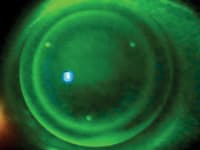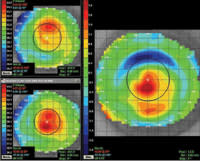orthokeratology
today
Ortho-k
for Hyperopia
BY JOHN MOUNTFORD,
DIP. APP. SC, FAAO, FCLSA
Orthokeratology is a rapidly changing science. The procedure is primarily aimed at treating the myopic population, but newer designs also allow us to use these lenses to treat hyperopia. From a historical historical perspective, George Jessen stated in his original lecture on "orthofocus" that hyperopia responded better to treatment than did myopia because of the edema he induced with a PMMA De Carle bifocal.
We can't induce excessive edema with overnight wear, so a different approach is necessary. Jerry Legerton, OD, MS, MBA, FAAO, is adapting the sigmoid proximity curve on the Paragon CRT lens, while Dr. Tung is using spherical curves with the Vipok design. In Australia, we're working on multi-aspheric designs.
|
|
|
| Figure 1. Pre-fit, post-wear and difference topography maps. | |

|
|
| Figure 2. Fluorescein pattern with pooling in central area. |
Although we're in the early days as far as ortho-k for hyperopia is concerned, the results look promising. The following case history is a good example.
The Unhappy Hyperope
A 63-year-old female presented with a history of LASIK for hyperopia that had initially been successful, but the effect "wore off" over the following six months to where her refraction and vision changed to OD +1.75 –1.25 x 50 (20/30), OS +1.25 –0.75 x 25 (20/25). She was dissatisfied with her unaided vision (20/60 OU) and also with her corrected vision. The rest of her ocular examination was unremarkable with the exception of mild dry eye. We asked her to take part in a trial of overnight orthokeratology for the correction of hyperopia.
We fit her with bi-aspheric Boston XO (B&L) trial lenses approximately 2.50D steeper than K in both eyes. Following one night of overnight wear, we found no clinical signs of edema or staining and a mild reduction (0.50D) in her refraction. We dispensed the trial lenses to wear for 10 nights and scheduled her to come in for evaluation within two hours of lens removal following the tenth night.
The Happy Hyperope
The patient presented with a big smile and reported excellent vision, "as though the fog had been lifted." Unaided VA was OD 20/20 and OS 20/15, with a refraction of OD +0.25 –0.75 x 30 and OS +0.25 –0. 25 x 20. Biomicroscopy was normal.
Figure 1 shows the pre-fit, post-wear and difference maps. Note the irregular astigmatism in the pre-fit plot and the central steepening of 1.50D post wear, as well as the reduction in astigmatism.
Figure 2 shows the fluorescein pattern. Hyperopic lenses work in the opposite direction to myopic ortho-k lenses in that the central area is fit steep and the paracentral area has an annulus of compression. The peripheral zone still controls centration.
The patient originally intended to suspend lens wear after a few weeks while on an overseas trip, but she was so delighted that she asked me if she could take them with her on vacation, as she could not stand the thought of looking through the fog again. How could I refuse?
Dr. Mountford is an optometrist in private practice specializing in advanced contact lenses for keratoconus, post refractive surgery and pediatric aphakia. He is a visiting contact lens lecturer to QUT and UNSW, Australia.




